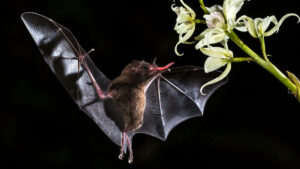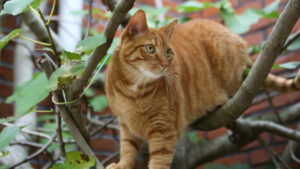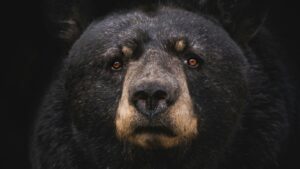Giraffes, those leggy wonders of the animal kingdom, have always been the head-turners of the savannah, and we mean that quite literally! The question of why giraffes have such absurdly long necks has intrigued scientists, researchers, and nature enthusiasts for centuries. Enter the captivating realm of giraffes, where we explore the evolutionary forces that shaped their iconic feature and made them nature’s original Stretch Armstrong. We also cover the benefits — and challenges of having such long necks.
Evolutionary origins: The tall tale of giraffes’ long necks
To understand why giraffes have long necks, we must rewind the reel of time to their evolutionary beginnings. The ancestors of modern giraffes were more like regular deer, not the lanky creatures we know today. Over millions of years, nature decided to play a little prank on them.
The first joke it pulled was the “long neck mutation.” Giraffes started growing necks like spaghetti strands. And then came the punchline — competition for food. Short-necked giraffes were like kids trying to reach the cookie jar on the highest shelf, while the long-necked ones had the ultimate advantage. They could chow down on the top-shelf foliage, which meant more greens, fewer tears.
Giraffe anatomy: ‘Bendy straws’ of nature

Giraffes’ necks are like the bendy straws of the animal kingdom. They have the same seven neck vertebrae as most mammals, including your Aunt Mildred, who insists on using a dozen straws in her iced tea. But these neck vertebrae are like something out of a Dr. Seuss book — elongated and ready for some serious neck gymnastics.
Benefits of long necks
The long necks provide several benefits for giraffes. This includes:
- Access to high foliage: The most obvious benefit of having a neck that rivals a fire ladder is the ability to reach high foliage. Giraffes can literally out-stretch their competitors and enjoy a buffet of leaves, flowers, and fruits from the treetop penthouse, as detailed by BBC Wildlife.
- Reduced competition: Short-necked herbivores must’ve felt like they were trying to hail a taxi during rush hour. Giraffes’ long necks meant they didn’t have to fight as many dinner guests for a seat at the table. Less competition means more legroom, or in this case, neckroom.
- Efficient digestion: The giraffe’s long neck isn’t just for show — it’s a food delivery system. They can hoover up a ton of food quickly and then take a leisurely stroll to chew the cud. It’s like getting takeout delivered to your doorstep — efficient and convenient.
- Survival advantage: Giraffes with their skyscraper necks can spot predators from a mile away. Think of it as nature’s early warning system — “Hey, lions are on the horizon, folks! Time to leg it!” Their long legs also pack a powerful kick to fend off hungry predators.
- Social interactions: Long necks also play a role in social interactions. Male giraffes use their necks in necking battles, swinging their heads like sledgehammers to establish dominance and secure mating rights. These neck-swinging showdowns are the giraffe equivalent of a rap battle, only with more head-banging and less rhyming.
Challenges of long necks
While the benefits of having long necks are evident, there are also challenges that come with this unique adaptation:
- Blood pressure regulation: Keeping blood flowing uphill to that lofty head can be a challenge. Giraffes’ hearts are like the muscle-bound bouncers of the circulatory system, ensuring the VIP blood supply reaches their brains.
- Vulnerability during drinking: When giraffes bend down to take a sip, they’re basically inviting predators for a “come and get it” moment. However, they have developed an interesting drinking technique by splaying their front legs apart and bending their knees to reach the water without putting their heads too low. It’s part yoga, part contortionism, and entirely hilarious.
- Thermoregulation: A long neck also means a lot of neck to manage when it comes to body temperature. But giraffes have a cool trick — a heat-dissipating network of blood vessels that doubles as a portable radiator.
Giraffes: Nature’s masterclass in reaching for the stars
The elongated neck of the giraffe is a remarkable example of how evolution shapes species to thrive in their environments. After all, when life gives you lemons, some animals get long necks, and others get really good at making lemonade! While it may seem like a simple question — “Why do giraffes have long necks?” — the answer reveals a complex interplay of ecological factors, competition for resources, and survival strategies.
In summary, giraffes’ long necks have evolved to provide them with unparalleled access to food, reduce competition, aid in efficient digestion, enhance their survival against predators, and facilitate social interactions. This iconic feature exemplifies evolution’s quirkiness and knack for turning challenges into advantages. Furthermore, giraffes stand as a testament to nature’s masterclass in “reaching for the stars” and the incredible diversity of life on our planet.
RELATED: Dog Breaks World Record for the Longest Tongue — Longer Than a Soda Can!
Header image: Giraffes / Melissa van Niekerk via Unsplash
I’m Mark Putzer, and my passion for animals and all things nature is a life-long love affair. Growing up in Wisconsin, I had many cherished memories of hiking, skiing, and enjoying the abundant wildlife in the Badger State.
My passion for animals led me to marine biology research for my studies at the University of Wisconsin. I researched the behavior and communication of humpback whales around Hawaii and Orca Whales around the San Juan Islands of Washington State. The experience of being close to these massive and magnificent creatures is amazing. Later, I taught outdoor education to children in California — passing along my knowledge of animals and nature to the curious minds of the next generation. I also love pets. This includes a Labrador Retriever dog named “Molly” when I was a kid — and now, an adventurous tabby cat named “Rosy.”
I’m here to share the wonders of the animal kingdom with you. Whether it’s a cherished pet at home or an animal out in the wild, there are many unique stories and interesting information to share on Weird Animal News! Enjoy!





















